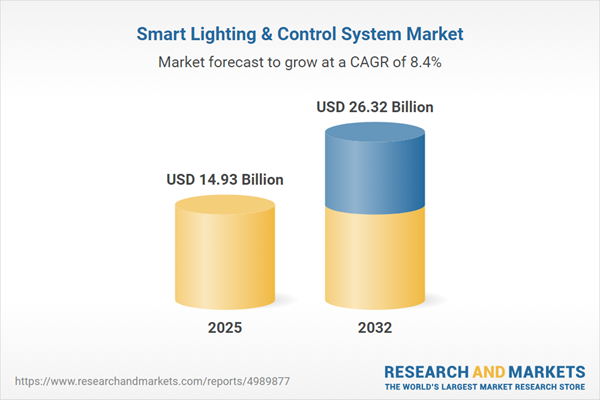Speak directly to the analyst to clarify any post sales queries you may have.
Senior leaders are reimagining how smart lighting and control system solutions drive enterprise efficiency, resilience, and sustainability. Strategic adoption of intelligent infrastructure is now central to staying competitive in a landscape of rising compliance requirements and rapid digital transformation.
Market Snapshot: Smart Lighting & Control System Market
The global smart lighting and control system market is experiencing robust growth, led by strong adoption across commercial, industrial, residential, and public domains. Market revenue is forecasted to increase from USD 13.84 billion in 2024 to USD 14.93 billion in 2025, reaching USD 26.32 billion by 2032 and reflecting a sustained compound annual growth rate of 8.36%. As organizations respond to energy efficiency mandates, digital innovation, and shifting regulatory demands, sustainability strategies play a pivotal role in accelerating technology uptake. Regional differences in infrastructure maturity and regulatory alignment further influence local deployment decisions, emphasizing the need for adaptable approaches.
Scope & Segmentation of the Smart Lighting and Control System Market
- Product Types: Incorporates intelligent controllers, modular fixtures, advanced networking switches, dimmers, sensor-based platforms, software management tools, and comprehensive lifecycle support packages tailored for enterprise settings.
- Lighting Technologies: Encompasses LED, fluorescent, and high-intensity discharge options, aligning product selection with operational efficiency and green objectives unique to each sector.
- Installation Types: Facilitates both retrofitting and new-build integration using modular system designs that reduce deployment time and support agile business requirements.
- Applications: Spans offices, logistics and warehousing hubs, healthcare institutions, manufacturing centers, hospitality properties, public infrastructure, and multi-family residential complexes, each benefitting from improved compliance and higher productivity.
- End Users: Serves commercial organizations, industrial manufacturers, residential communities, and public entities—all focusing on heightened performance and sustainability outcomes.
- Sales Channels: Offers flexibility via direct procurement, distributor networks, and digital B2B platforms, ensuring ongoing system support and adaptable sourcing.
- Geographical Coverage: Addresses diverse market dynamics in the Americas, Europe, Middle East and Africa, and Asia-Pacific, acknowledging varying rates of adoption tied to infrastructure and regulatory factors.
- Key Companies: Features Eaton Corporation PLC, ams-OSRAM AG, Acuity Brands, Dhyan Networks and Technologies, Dialight PLC, Dimonoff inc., Gewiss S.p.A., Govee Moments Trading Limited, Havells India Limited, Helvar Merca Oy Ab, Honeywell International Inc., Ideal Industries, Johnson Controls International plc, Koninklijke Philips N.V., Legrand S.A., Lifi Group, Lightwaverf PLC, Lutron Electronics Co., Murata Manufacturing Co., Nhance Digital Buildtech Private Limited, Panasonic Holdings Corporation, QTL Inc., Rab Lighting Inc., Schneider Electric SE, Schréder SA, Siemens AG, Snap One LLC, Tuya Inc., and Zumtobel Group AG.
Key Takeaways for Senior Decision-Makers
- Smart lighting and control systems generate actionable insights through real-time data and analytics, empowering leaders to optimize enterprise operations and plan proactively.
- Compatibility is streamlined by integrating open communication protocols such as Zigbee, Thread, and Matter, helping organizations evolve system capabilities while leveraging current infrastructure.
- Collaborations with established technology partners increase operational resilience and strengthen supply chain flexibility under changing business conditions.
- Circular economy models and performance-based contracts improve project value and support sustainability goals throughout the asset lifecycle.
- Coordination among manufacturers, system integrators, and service providers ensures tailored deployment that aligns with varied regulatory environments and organizational objectives worldwide.
Tariff Impact: Navigating Cost and Supply Chain Pressures in 2025
Recent adjustments to U.S. tariffs underscore the necessity of evaluating supplier portfolios and diversifying regional sourcing. Expanding supplier networks and refining procurement strategies support cost management and help protect continuity in a shifting trade environment.
Methodology & Data Sources
This market intelligence combines executive interviews, insights from system integrators, and feedback from primary end users, together with regulatory and engineering benchmarks. The research approach delivers a balanced perspective for senior management engaged in smart lighting and control system strategies.
Why This Report Matters: Strategic Outcomes for Leaders
- Enables alignment of smart lighting and control system planning with enterprise-wide resilience, growth, and sustainability priorities.
- Offers practical guidance for optimizing procurement and advancing scalable technologies, boosting operational reliability and environmental integration.
- Prepares leadership teams to address regulatory shifts and rising expectations around efficiency and long-term value.
Conclusion
This report provides senior executives with informed insights to enable adaptive investments, guiding strategic enterprise actions in the evolving smart lighting and control system market.
Additional Product Information:
- Purchase of this report includes 1 year online access with quarterly updates.
- This report can be updated on request. Please contact our Customer Experience team using the Ask a Question widget on our website.
Table of Contents
3. Executive Summary
4. Market Overview
7. Cumulative Impact of Artificial Intelligence 2025
Companies Mentioned
The companies profiled in this Smart Lighting & Control System market report include:- Eaton Corporation PLC
- ams-OSRAM AG
- Acuity Brands, Inc.
- Dhyan Networks and Technologies, Inc.
- Dialight PLC
- Dimonoff inc.
- Gewiss S.p.A.
- Govee Moments Trading Limited
- Havells India Limited
- Helvar Merca Oy Ab
- Honeywell International Inc.
- Ideal Industries, Inc.
- Johnson Controls International PLC
- Koninklijke Philips N.V.
- Legrand S.A.
- Lifi Group
- Lightwaverf PLC
- Lutron Electronics Co., Inc.
- Murata Manufacturing Co., Ltd.
- Nhance Digital Buildtech Private Limited
- Panasonic Holdings Corporation
- QTL Inc.
- Rab Lighting Inc.
- Schneider Electric SE
- Schréder SA
- Siemens AG
- Snap One, LLC
- Tuya Inc.
- Zumtobel Group AG
Table Information
| Report Attribute | Details |
|---|---|
| No. of Pages | 181 |
| Published | November 2025 |
| Forecast Period | 2025 - 2032 |
| Estimated Market Value ( USD | $ 14.93 Billion |
| Forecasted Market Value ( USD | $ 26.32 Billion |
| Compound Annual Growth Rate | 8.3% |
| Regions Covered | Global |
| No. of Companies Mentioned | 30 |









